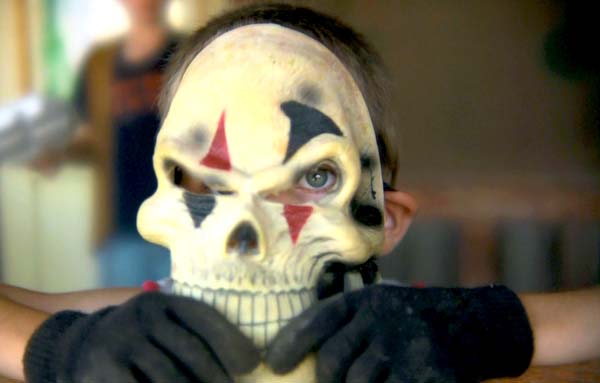
Benny at play (Photo: Boaz Yakin Presents)
Directed by Alma Har’el
Produced by Har’el & Boaz Yakin
Released by Boaz Yakin Presents
USA. 80 min. Not Rated
Director Alma Har’el takes a rambling tour of the human fauna in a Sonoran Desert ghost town at the southeastern tip of California. Over the course of a year, she uses several different visual techniques in following the flotsam and jetsam living in what feels like the end of the world. A too-brief prologue provides some historic background on the hopes and dreams that came when the damming of the Colorado River in the 1930s created the man-made Salton Sea. A montage of photographs and promotional footage shows the development of the Bombay Beach resort in the 1950’s as a tourist town with celebrity visitors—until nature struck back by flooding the area with salt.
Amidst the several hundred people on the abandoned salt flats are a large family, a teenage boy, an old coot, and miscellaneous characters of varying appeal. Each has reasons to choose this isolated way of life. Clips from negative TV news coverage provide some background, particularly of the Parrish family. The extended family grew up playing and videotaping war games where they would blow up ammunition, which just seemed eccentric to the locals until 9/11. That brought the attention of the authorities, who determined the house was dirty and the children neglected. The parents were sent to prison and the children into foster care. Now reunited, they seem to be trying hard to prove they can keep their family together, despite the great difficulties of being poor in rural America, particularly with a health care system that substitutes over-medication for services.
CeeJay’s story is also first illustrated with news clips, of gang violence in South Central Los Angeles, where his cousin was shot to death. His family sent him to relatives in Bombay Beach to stay out of trouble and focus on playing high school football as a way out of trouble and onto college. He not only has to adapt to the quiet environment, where he sticks out as one of the few African Americans, but he also becomes distracted by falling in love.
It is no surprise that old timer Red is estranged from his ex-wife, adult children, and almost any civilized person, other than the addicts to whom he illegally sells tax-free loose cigarettes from the nearby Indian reservation. Whenever was ticked off about anything and everything, he would take his trailer, his home, on the road. However, old age and health problems may finally defeat him now that he’s too frail to travel and the trailer has broken down. But with too much screen time, his ornery personality, racist views, and penchant for ranting on and on quickly become tiresome.
While their daily doings are filmed in (almost overly) intimate cinema vérité, Har’el finds a creative route into their interior lives. The Parrishes youngest son Benny has increasingly disruptive behavioral problems at school, but in front of the camera he acts out complicated fantasy play around the town’s ruins. The depressing tedium of their lives is offset by charming dance numbers, choreographed by Paula Present and set to songs by Bob Dylan and Zach Condon—their participation seems like the director’s gift to the townspeople in exchange for her intrusive presence. (Present and Har’el have also collaborated on music videos for Condon’s band, Beirut.) In the best interlude, CeeJay dances at night wearing a white mask that enables him to comment on both local Halloween traditions and his yearning to fit in.
But even as the moody film is a compassionate portrait, it wanders around the mostly downtrodden too much, even with brief flashes of optimism. A documentary now making the festival rounds, Nick Brandestini’s Darwin, is more focused about a motley crew in another desolated ghost town in the California desert. It incorporates more direct interviews with the articulate residents of Death Valley. While they are almost as annoying as some in Bombay Beach, their perspectives are put in a more helpful context of place and personal history.






This film is amazing. In particular the camera and lens work and the mixing of documentary and music video styles. A visual and dramatic treat.